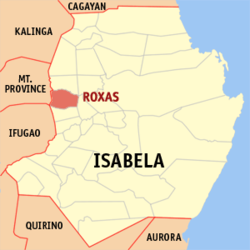Roxas (Isabela)
| Municipality of Roxas | ||
| Location of Roxas in the province of Isabela (province) | ||
|---|---|---|

|
||
| Basic data | ||
| Region : | Cagayan Valley | |
| Province : | Isabela (Province) | |
| Barangays : | 26th | |
| District: | 2. Isabela District (Province) | |
| PSGC : | 023105000 | |
| Income class : | 1st income bracket | |
| Households : |
May 1, 2000 census
|
|
| Population : | 23,784 August 1, 2015 census
|
|
| Population density : | 128.7 inhabitants per km² | |
| Area : | 184.80 km² | |
| Coordinates : | 17 ° 8 ′ N , 121 ° 36 ′ E | |
| Postal code : | 3320 | |
| Website: | Roxas website | |
| Geographical location in the Philippines | ||
|
|
||
Roxas ( Filipino : Bayan ng Roxas ) is a Filipino municipality in the province of Isabela , Administrative Region II, Cagayan Valley. It has 23,784 inhabitants (August 1, 2015 census) who lived in 26 barangays . It is classified as a first income class community in the Philippines and as partially urbanized . It was founded on July 1, 1948 and named after the first President of the Second Philippine Republic, by Elpidio Quirino .
Roxas is located in the western part of the province, at the foot of the Cordillera Central , in the valley of the Cagayan River . It is 385 km north of Manila and is accessible via the Marhalika Highway . The nearest airport is in Cauayan City , which is served by the Cebu Pacific airline four times a week. Their neighboring communities are San Manuel in the south, Burgos in the east, Paracelis in the west, Quirino in the northeast and Mallig in the north.
Barangays
|
|
Manuel Roxas statue

